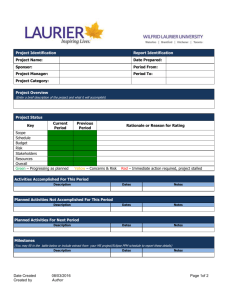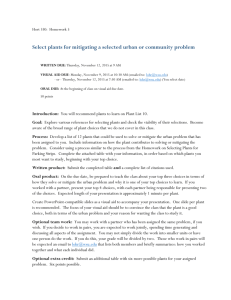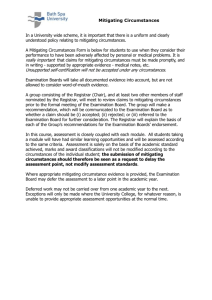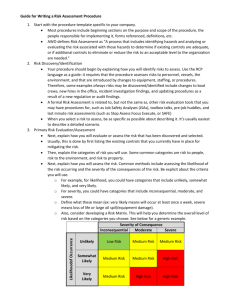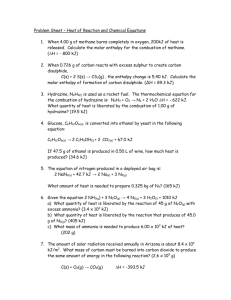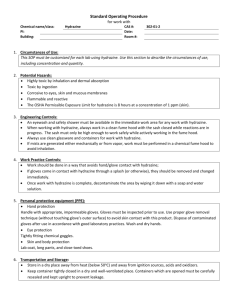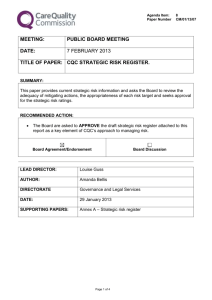Davis - A New Approach to Bounding EOC
advertisement
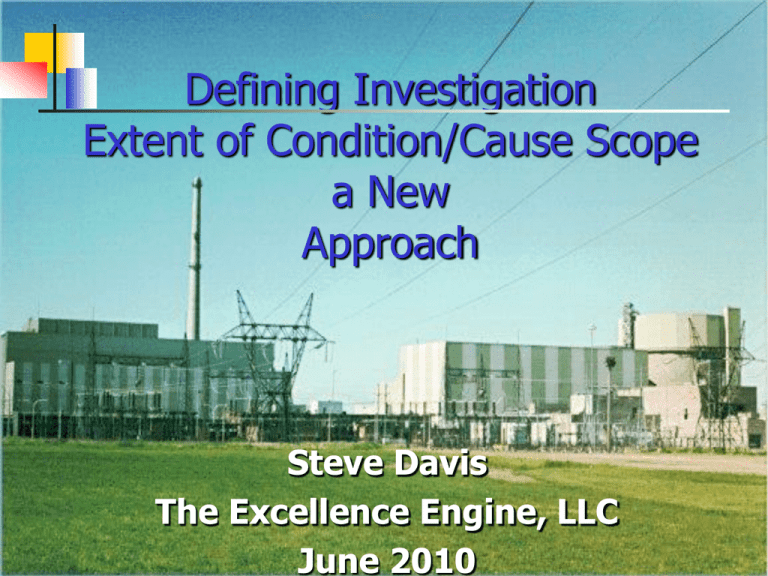
Defining Investigation Extent of Condition/Cause Scope a New Approach Steve Davis The Excellence Engine, LLC June 2010 Extent of Condition/Cause a.k.a. How big is this problem? Extent of Condition Transportability of condition - determine whether the same problem/condition exists elsewhere. Is the extent to which the condition may exist in other plant equipment, organizations, processes, or human performance. Why Perform an Extent of Condition Review? To identify down stream effects from the initial event. To identify possible event initiators and correct them prior to causing an additional event. Extent of Cause Transportability of cause - determine whether the same root or underlying causes of the problem/condition may be affecting performance elsewhere (other plant processes, equipment, or human performance). Why Perform an Extent of Cause Review? To identify other places where this cause exists and correct them prior to causing an additional event. The Problem Extent of Cause/Condition review too narrow. Extent of Cause/Condition review too broad. Extent of Cause/Condition review just right but is criticized as being too broad/narrow. Extent of Cause/Condition review assesses the wrong areas. The Solution A Risk Based Approach to Setting Extent of Condition/Cause Assessment Scope Risk Based Three Step Approach First, define other potential instances of the same/similar condition/cause(s). Second, determine the risk of a similar event occurring with the same/similar condition/cause(s) by assigning a probability of occurrence and level of consequence if no corrective or preventive actions are taken. Third, decide if action is required. Define Potential Same/Similar Conditions Restate the event / problem and critical setup conditions Define Same/Similar using the following criteria. –Same - Same Same Program [e.g., CAP] or Process [e.g., Surveillance Scheduling] or System [Auxiliary Steam] with the Same kind of problem/error/failure or defect. Same Object – Same Defect –Same - Similar Same Program [e.g., CAP vs. Self-Assessment] or Process [e.g., Surveillance Scheduling vs. 13-Week Scheduling] or System [Auxiliary Steam vs. Heater Drains] with a Similar kind of problem/error/failure or defect. Same Object – Similar Defect –Similar - Similar Similar Program [e.g., CAP vs. Self-Assessment vs. Management Oversight] or Process [e.g., Surveillance Scheduling vs. 13-Week Scheduling vs. WM] or System [Auxiliary Steam vs. Heater Drains vs. Main Steam] with a Similar kind of problem/error/failure or defect. Similar Object – Similar Defect Define Potential Same/Similar Causes Restate the problem statement and identified cause. (Typically just the Root Cause or principal Apparent Cause) Define Same/Similar using the following criteria. –Same - Same Same Same Same Cause – Same Impacts –Same - Similar Same Similar Same Cause – Similar Impact –Similar - Similar Similar Similar Similar Cause – Similar Impact Set the Scope of the Assessment Using the defined Same/Similar conditions/ cause(s): Determine the consequences for each defined potential condition/cause. Evaluate the chance of occurrence for each defined potential condition/cause. Identify the Risk for each defined potential condition/cause. Bound the Extent of Condition evaluation based on the defined risk. (e.g. No Risk = No evaluation) Nails in Tires Consequence Other Foreign Material Problems with the New Roof Similar - Similar Roofing Nails In Driveway Roofing Nails In Other Places Same - Same Same - Similar Roofer Foreign Material Mgt. Extent of cause Same - Same © 2003, William R. Corcoran, NSRC Corp., 860-285-8779, firebird.one@alum.mit.edu Suggested Extent of Condition Analysis Template Set up Conditions Problem / Event Extent of Condition Potential SAME – SAME Condition RISK MITIGATING ACTIONS Potential SAME – SIMILAR Condition RISK MITIGATING ACTIONS POTENTIAL SIMILAR - SIMILAR RISK CONDITION MITIGATING ACTIONS ©2008 The Excellence Engine Suggested Extent of Cause Analysis Template Problem Statement Apparent / Root Cause Extent of Cause Potential SAME – SAME Impacts RISK MITIGATING ACTIONS Potential SAME – SIMILAR Impacts RISK MITIGATING ACTIONS POTENTIAL SIMILAR SIMILAR IMPACTS RISK MITIGATING ACTIONS ©2008 The Excellence Engine Extent of Condition/Cause Assessment Definition Matrix Definition Matrix ©2008 The Excellence Engine Extent of Condition/Cause Assessment Risk Matrix Risk Matrix ©2008 The Excellence Engine Extent of Condition/Cause Assessment Mitigating Actions Matrix Mitigating Actions Matrix ©2008 The Excellence Engine Extent of Condition/Cause Assessment Risk to Action Matrix Definition Matrix Mitigating Actions Matrix Application Extent of Condition Risk Extent of Cause Same Object Same Object Similar Object Same Cause Same Cause Similar Cause Same Defect Similar Defect Similar Defect Same Result Similar Result Similar Result Recurrence Consequences Catastrophic Critical Marginal Negligible Frequent / Probable High High Medium Medium Occasional High High Medium Low Remote High Medium Low Low Improbable Medium Medium Low Low Risk Matrix ©2008 The Excellence Engine Application High Medium Low Similar Similar Evaluate & Correct as needed. Management Discretion No Action Same Similar Evaluate & Correct as needed. Management Discretion Management Discretion Same Same Evaluate & Correct as needed. Evaluate & Correct as needed. Evaluate & Correct as needed. Example Problem A few gallons of hydrazine contaminated with sodium hydroxide waste was pumped from the secondary hydrazine addition tank to the Auxiliary Feedwater Storage Tank, which was being used to feed the Steam Generators while the plant was in Hot Standby. Extent of Condition Example Set up Conditions An empty hydrazine drum filled with sodium hydroxide waste was not labeled per station requirements. The waste drum was later mistaken for a new drum of hydrazine and its contents were added to the secondary hydrazine addition tank. Problem / Event A few gallons of hydrazine contaminated with sodium hydroxide waste was pumped from the secondary hydrazine addition tank to the Auxiliary Feedwater Storage Tank, which was being used to feed the S/Gs while the plant was in Hot Standby. Extent of Condition Potential SAME – SAME Condition What other systems or tanks are contaminated due to transfer from the secondary hydrazine addition tank or other direct transfers from the contaminated waste drum? Potential SAME – SIMILAR Condition Are there any other mislabeled drums that could mistakenly be added to the same or other plant systems? POTENTIAL SIMILAR – SIMILAR CONDITION Are there any other chemical transfer tasks that could be mistakenly performed because of a labeling error? ©2008 The Excellence Engine RISK MITIGATING ACTIONS RISK MITIGATING ACTIONS RISK MITIGATING ACTIONS Extent of Condition/Cause Assessment Risk to Action Matrix Definition Matrix Mitigating Actions Matrix Application Extent of Condition Risk Extent of Cause Same Object Same Object Similar Object Same Cause Same Cause Similar Cause Same Defect Similar Defect Similar Defect Same Result Similar Result Similar Result Recurrence Consequences Catastrophic Critical Marginal Negligible Frequent / Probable High High Medium Medium Occasional High High Medium Low Remote High Medium Low Low Improbable Medium Medium Low Low Risk Matrix ©2008 The Excellence Engine Application High Medium Low Similar Similar Evaluate & Correct as needed. Management Discretion No Action Same Similar Evaluate & Correct as needed. Management Discretion Management Discretion Same Same Evaluate & Correct as needed. Evaluate & Correct as needed. Evaluate & Correct as needed. Extent of Condition Example Set up Conditions An empty hydrazine drum filled with sodium hydroxide waste was not labeled per station requirements. The waste drum was later mistaken for a new drum of hydrazine and its contents were added to the secondary hydrazine addition tank. Problem / Event A few gallons of hydrazine contaminated with sodium hydroxide waste was pumped from the secondary hydrazine addition tank to the Auxiliary Feedwater Storage Tank, which was being used to feed the S/Gs while the plant was in Hot Standby. Extent of Condition Potential SAME – SAME Condition What other systems or tanks are contaminated due to transfer from the secondary hydrazine addition tank or other direct transfers from the contaminated waste drum? Potential SAME – SIMILAR Condition Are there any other mislabeled drums that could mistakenly be added to the same or other plant systems? RISK Probable & Critical = HIGH RISK MITIGATING ACTIONS Evaluate & Correct RISK Probable & Critical = HIGH RISK MITIGATING ACTIONS Evaluate & Correct POTENTIAL SIMILAR – SIMILAR CONDITION Are there any other chemical transfer tasks that could be mistakenly performed because of a labeling error? RISK Remote & Critical = MEDIUM RISK MITIGATING ACTIONS Mgmt. Discretion ©2008 The Excellence Engine Extent of Cause Example Problem Statement A few gallons of hydrazine contaminated with sodium hydroxide waste was pumped from the secondary hydrazine addition tank to the Auxiliary Feedwater Storage Tank, which was being used to feed the S/Gs while the plant was in Hot Standby. Apparent / Root Cause Willful violation (i.e. shortcut taken) on the part of the individual responsible for labeling the waste drum. Extent of Cause Potential SAME – SAME Impacts RISK Has the same individual taken shortcuts when labeling other waste drums? MITIGATING ACTIONS Potential SAME – SIMILAR Impacts Has the same individual taken any other safety significant shortcuts? POTENTIAL SIMILAR – SIMILAR IMPACTS Are other individuals in the same work group willfully violating labeling requirements? ©2008 The Excellence Engine RISK MITIGATING ACTIONS RISK MITIGATING ACTIONS Extent of Condition/Cause Assessment Risk to Action Matrix Definition Matrix Mitigating Actions Matrix Application Extent of Condition Risk Extent of Cause Same Object Same Object Similar Object Same Cause Same Cause Similar Cause Same Defect Similar Defect Similar Defect Same Result Similar Result Similar Result Recurrence Consequences Catastrophic Critical Marginal Negligible Frequent / Probable High High Medium Medium Occasional High High Medium Low Remote High Medium Low Low Improbable Medium Medium Low Low Risk Matrix ©2008 The Excellence Engine Application High Medium Low Similar Similar Evaluate & Correct as needed. Management Discretion No Action Same Similar Evaluate & Correct as needed. Management Discretion Management Discretion Same Same Evaluate & Correct as needed. Evaluate & Correct as needed. Evaluate & Correct as needed. Extent of Cause Example Problem Statement A few gallons of hydrazine contaminated with sodium hydroxide waste was pumped from the secondary hydrazine addition tank to the Auxiliary Feedwater Storage Tank, which was being used to feed the S/Gs while the plant was in Hot Standby. Apparent / Root Cause Willful violation (i.e. shortcut taken) on the part of the individual responsible for labeling the waste drum. Extent of Cause Potential SAME – SAME Impacts RISK Has the same individual taken shortcuts when labeling other waste drums? Probable & Critical = HIGH RISK MITIGATING ACTIONS Evaluate & Correct Potential SAME – SIMILAR Impacts Has the same individual taken any other safety significant shortcuts? RISK Probable & Marginal = MEDIUM RISK MITIGATING ACTIONS Evaluate & Correct POTENTIAL SIMILAR – SIMILAR IMPACTS Are other individuals in the same work group willfully violating labeling requirements? RISK Improbable & Marginal = LOW MITIGATING ACTIONS No Action ©2008 The Excellence Engine Risk Based Approach to Setting Extent of Condition/Cause Assessment Scope Value-Added Provides standardized approach for setting extent of condition/cause assessment scope. Makes thinking visible. Simplifies identifying appropriate corrective actions. Questions??? Steve Davis Steve.davis@excellence-engine.com 315-593-3447 315-532-4742 Chet Rowe Chet.rowe@excellence-engine.com 315 207-3018 315-591-2159
